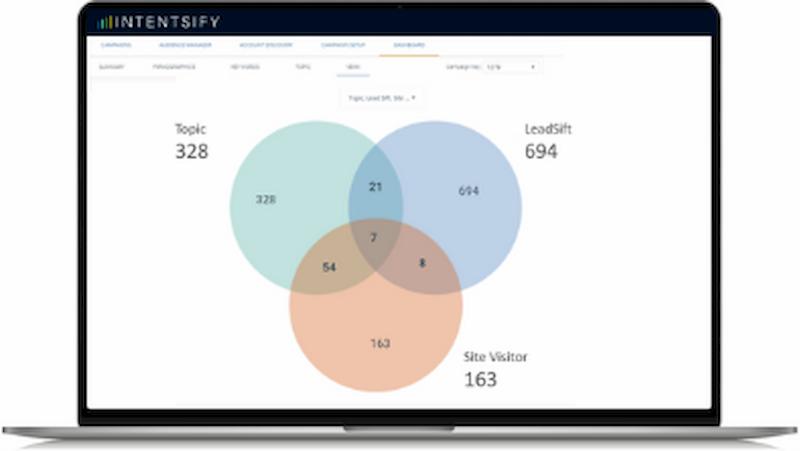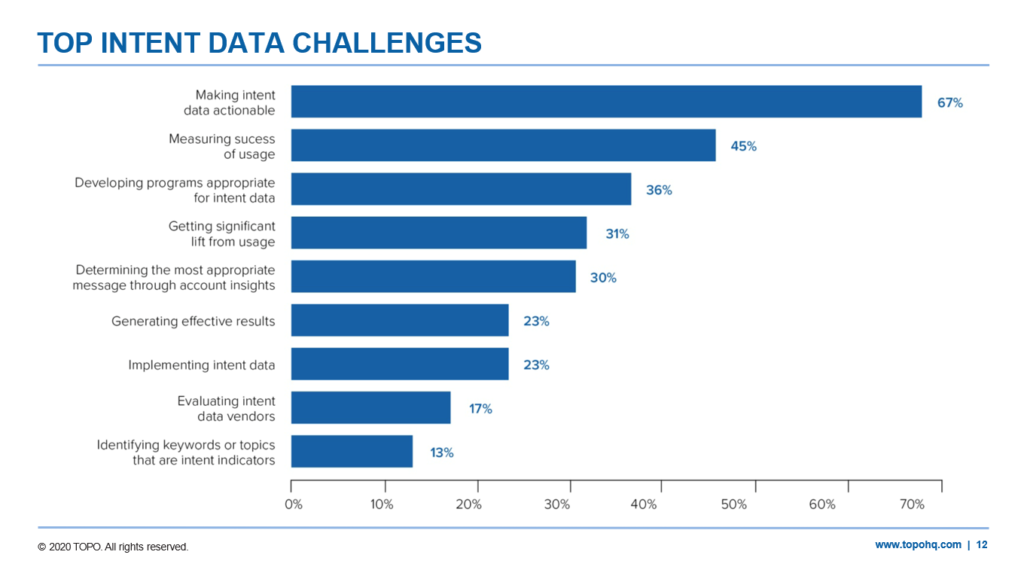Intent Activation™: New Category Of Intent-Focused MarTech
Intent Data | August 4, 2020 | by David Crane

Click here to listen to the article
A Growing Challenge for B2B Marketing Teams
The B2B buying process has become increasingly difficult. The typical buying group involves six to 10 decision makers. More importantly, according to Gartner, each decision maker is armed with four or five pieces of independently gathered, often conflicting information.[1]
Deconflicting this information to arrive at a consensus among a large group is a complicated, arduous, and unenjoyable endeavor. In fact, Gartner research shows “77% of B2B buyers state that their latest purchase was very complex or difficult.”[2]
B2B marketing organizations that help their prospects navigate buying-process complexities win. As a recent LeadMD survey report states,
“B2B buyers want straight-forward, no BS messaging that tells them how your product or service will help them. They want you to understand their circumstances and be direct.”[3]
This, however, isn’t as easy as it may seem.
The buying process comprises numerous stages and the journey is anything but linear. More than just understanding the buying stages and how to support prospects’ efforts to navigate them, B2B marketers must have the right strategies, resources, and information needed to aid their prospects.
The Promise of Intent Data
Intent data can certainly help. Providing a view into the current interests, challenges, and needs of target audiences, intent data enables marketers to supply prospective buyers with the information they need, when they need it.
Across a range of data sources and types, intent signals provide glimpses into what target accounts are currently researching and to what extent. Some intent sources offer a broad, global view, while others provide a more concentrated, nuanced picture. Some sources derive signals from first-party interactions, while others aggregate data across a cooperative of third-party web properties. Some focus on content consumption among walled gardens, others gather data among public domains.
Most important, though, is that each intent data type holds complementary values to one another. Accessing multiple intent data sources ensures both broad and in-depth coverage of businesses’ buying-research activities.
Why, Then, Does Intent Data Fall Short of Expectations?
Simply put: disparate sources hinder the actionability of intent data.
All the various sources and types of intent data remain largely fragmented. They provide B2B marketers with quick snap shots of prospective buyers’ research activities, but their respective siloes prevent the full view of the market landscape.
Because each data source monitors intent signals captured across differing web properties using differing methodologies, they’re each only capable of providing information from a very specific angle. In the words of Kathy Macchi, VP of Consulting Services at Inverta:
“Many marketers aren’t using intent data as well as they could, and the activation piece is the biggest need. But the data and insights are often kept in siloes—so there’s no cohesive picture. When this is the case, it’s hard to make cogent inferences around intent data and know what to do with them.”
It’s important to put this in the real-world context of today’s B2B buying committees. An eight-person committee will comprise numerous roles across several teams, each with its own goals, challenges, needs, and concerns. It’s unlikely an IT director on a buying committee is consuming the same content as a sales VP—or even researching the same problem.
Now add to these variables the vast range of ways individuals conduct research based on their own preferences—white papers, podcasts, blog posts, webinars, product review sites, analyst reports, case studies, etc.—each catering to specific departments, if not specific roles. The result is a ton of differing intent signals. Accessing only a small percentage of them through a single intent data feed can skew insights in an unhelpful way.
The Importance and Challenges of Activating Multiple Intent Data Sources
Reaping the full benefits of intent data requires aggregating multiple sources to provide broad online coverage and verify the strongest signals.
To be sure, verifying intent signals is key. It’s like the difference between having one or several key witnesses in a criminal trial. If two or more intent sources highlight the same signals, it’s a substantially stronger indication of buying intent.
Even if several intent sources monitor the same web properties, they often use differing scoring methodologies. For example, sources often vary in the way they value the relevancy of a specific piece of content to a certain topic or keyword, meaning their results can differ significantly. But when you aggregate multiple intent sources, it’s much easier to identify the strongest, verified buying signals, which you otherwise would’ve missed. Further, when leveraging multiple intent sources, it’s easier to discard any outlier signals that aren’t very strong (i.e., not verified by another source).
Simply put, layering multiple intent sources increases potential value. You get a more complete and accurate picture of the market, allowing for more efficient and effective marketing efforts. This is why a recent TOPO report states,
“Enterprise companies have an insatiable appetite for data, specifically the data that indicates prospect interest. We’ve seen companies buy all the intent data they can from multiple sources.”[4]
Unfortunately, most B2B marketing teams are ill-equipped to properly aggregate, digest, and act on insights compiled across multiple intent data sources. The same TOPO report and a subsequent webinar substantiate this finding. TOPO analysts explain that while B2B marketing teams are rightly investing heavily across diverse intent data sources, the No.1 challenge marketers face with their intent data investments is “Making intent data actionable.” In fact, 67% of those surveyed acknowledged having this challenge, exceeding the No.2 challenge by 22 percentage points.

Intent data should be used as a foundational B2B marketing resource, supporting nearly all activities, from the top-of-funnel brand awareness to post-sale account expansion. Instead, the value of intent data remains hamstrung by marketing teams’ inability to easily aggregate and activate multiple intent sources.
B2B Marketing Needs a New Solution
The intent data category has grown rapidly in recent years. But while many intent data providers strive to explain why their data is superior to competing sources or types, which are typically complementary, the bigger problems remain:
- Each intent feed only provides a piece of a confusing picture, preventing the full, accurate view B2B marketers require to support buyers’ needs by getting the right information to the right individuals when they’re ready for it.
- Acting on intent signals remains tedious; marketers can’t easily digest all the data, verify the signals, draw decisive conclusions, and distribute the insights across all the teams responsible for acting on it.
B2B marketing is ready for a new category of intent-focused marketing technology (martech) to tackle these challenges. And that’s exactly what we’re building at Intentsify.
Enter Intent Activation™
When Intentsify launched two years ago, the founders were confident in the strength of Intentsify’s proprietary intent data and that it would produce valuable signals for B2B marketers. More importantly, the founders—having been in intent data space for nearly a decade, using intent to develop Prelytix in 2012—also understood that one signal often isn’t enough, no matter how good the data is.
Mindful of both the importance and challenges of activating multiple intent sources, Intentsify’s founders focused on developing technology that would achieve two primary objectives:
- Layer numerous, complementary intent feeds into a broader and more precise picture of target-buyer needs, amplifying the strongest intent signals; and
- Make it simple for B2B marketers to act on intent insights across several key use cases.
Much of this vision has been accomplished. Intentsify’s Intent Activation™ software automates the aggregation and digestion of numerous intent data sources, providing a more holistic and granular view of target-account research activities. Further, we currently offer two intent-activation solutions for programmatic advertising and lead generation.
A once tedious workflow has become an efficient, effective way to quickly adjust demand generation efforts according to changing market needs. And customer benefits are numerous:
- Increased ROI on intent data investments
- Greater marketing efficiency—time, energy and resources are more quickly allocated to the right accounts, using the right messages, which leads to…
- Better prospect experiences, increased engagement, improved engagement quality, higher conversion rates, and greater customer retention and expansion, which lead to…
- A jump in marketing’s contribution to pipeline, and sales’ strengthened confidence in marketing, which lead to…
- More customers and revenue
Speaking of Intentsify’s Intent-Activated Lead Generation solution, John Phillips, Head of Demand Generation and Partnerships at Nerdery says:
"Identifying which target accounts are in an active buy-cycle was an important piece, but we still required an effective way to get decision-makers at those accounts to engage with our brand. Intentsify's intent-activated lead gen solution is the best and easiest way to both get your branded content in front of targeted personas at intent-identified accounts and convert them into quality top-of-funnel leads."
We’re well on the way to achieving the goals first envisioned by the Intentsify founders two years ago, but there’s far more value we’re currently working to create for our customers. In the coming months, we’ll be announcing new data integrations, user interface features, strategic data partnerships, activation solutions and more. If you’d like to learn more, please don’t hesitate to reach out to us.
[1] https://www.gartner.com/en/sales/insights/b2b-buying-journey
[2] Ibid.
[3] LeadMD, B2B Buyer Sentiments: Key takeaways and findings on COVID-19’s impact on buying habits and perception in B2B buyers; p.6.
[4] TOPO, Marketing Technology Survey Report: Executive Summary, p.5.


